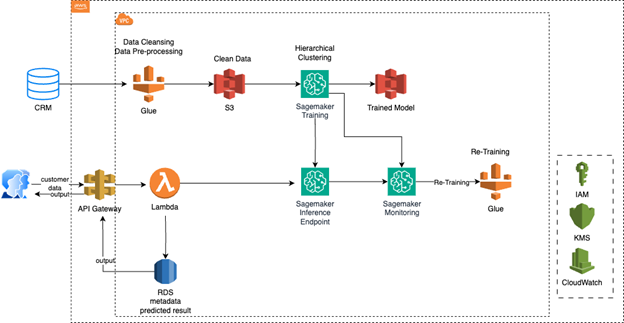Business Problem
Marketers face challenges in creating personalized and effective marketing collateral for segmented target audiences.
SolarPlexus aimed to solve these challenges by introducing hyper-personalization into mass marketing, achieving double-digit conversion rates and 60% higher ROI on marketing campaigns.
About Solarplexus
SolarPlexus is a Sweden-based SaaS Marketing solutions provider. Their product helps customers 10X their marketing outreach conversion by building real-time, hyper-personalized marketing content, leveraging underlying user persona & intelligence.
Solution
With the advent of Machine Learning and its capabilities to generate real-time, customized content, goML’s ML consulting team collaborated with the client to develop a product vision. This solution enables SolarPlexus clients to create hyper-personalized communications based on real-time user personas, resulting in a 10X increase in conversion rates.
The approach followed three key steps:
1.
Automated Branding for Collateral Standardization
Technology Used: Claude‑v2 with Retrieval-Augmented Generation (RAG) powered by AWS OpenSearch
Document Ingestion & Preprocessing
– Brand documents (style guides, PDFs, Notion pages) are broken down and preprocessed to enhance semantic understanding.
– Preprocessing includes OCR (if required), cleaning of boilerplate elements (e.g., headers, footers), and conversion into normalized plain text.
– Next, the content is segmented into semantically meaningful blocks such as section headers, bullet points, and design tokens.
– Each block is enriched with metadata (e.g., section title, document type, brand ID) to aid retrieval.
– These enriched chunks are then embedded using Bedrock embeddings and stored in AWS OpenSearch.
Chunking & Indexing Strategy
– Documents are split into ~300-token windows with a 50-token overlap to preserve cross-section coherence and inline references.
– Embedded vectors are generated using Amazon Bedrock’s Titan Embeddings (768 dimensions) and stored in AWS OpenSearch Serverless Collections.
– Index parameters:
– k-NN engine: faiss
– Vector dimension: 768
– Similarity metric: cosine
– Index refresh interval: 1s
– Hybrid fields: text, metadata.brand, metadata.component_type
Retrieval-Augmented Generation (RAG) Pipeline
– Removes manual configuration of brand assets—no need to upload logos or enter font/color codes.
– Ensures all generated collateral strictly adheres to brand guidelines and offers full traceability.
– Scalable: adding a new brand is as simple as uploading its document.
2.
ML‑Powered User Classification & Segmentation – Real‑Time Personalization
Technology Stack:
– Data ingestion via user-uploaded Excel or CSV files (tabular format)
– CRM data pipeline for syncing customer and engagement data from systems such as Salesforce, HubSpot, and Zoho CRM
– Data processing with Apache Spark
– Unsupervised clustering using HDBSCAN and hierarchical clustering for deep segmentation
Clustering Pipeline:
– A clustering model is chosen based on internal benchmarks—either HDBSCAN or hierarchical clustering—depending on data density, interpretability, and use case complexity
– Admin-defined preferences such as city, country, or job role directly influence which features are prioritized
– A large language model (LLM)-based engine automatically selects the most relevant features using statistical distribution analysis and domain metadata
– Numeric columns are binned into labeled intervals (e.g., age 18–24, 25–34) for categorical representation
– Categorical and textual fields are embedded using Sentence-BERT for high-dimensional semantic representation
– The resulting embeddings are clustered to identify behaviorally or demographically coherent segments
– Each cluster is named using an LLM-powered naming engine that analyzes column importance and intra-cluster value frequency to generate descriptive, business-readable labels
System Features:
– Every user record is mapped to a persistent segment_id for downstream personalization and campaign delivery
– Segments directly influence personalized messaging, recommendations, and UX customization in collateral generation
Impact:
– 30%+ increase in campaign click-through rates by targeting high-intent, high-affinity segments
– 80%+ reduction in manual segmentation workload through automated feature engineering and labeling
– Full scalability across marketing automation, CRM platforms, and product delivery workflows
3.
Hyper‑Personalization with ML‑Driven Content Generation
Technology Stack:
– Claude-v2 for dynamic text generation
– Stable Diffusion for AI-generated visuals
– Cosine similarity-based output validation
– Brand value augmentation from segmentation pipeline
Content Ingestion:
– In addition to segment metadata, users upload two files per campaign:
– Text-to-Individualize: Contains product/event details and brand copy to be used in text personalization
– Image-to-Individualize: Contains product image or reference visual to be integrated into generated visuals
– The uploaded image is also used to generate a semantic summary that is appended to the prompt for enhanced alignment
– Brand guidelines such as color palettes, tone of voice, and fonts (handled via frontend editor) are integrated into prompt construction and visual styling
Content Generation Pipeline:
– Segment metadata (e.g., behavioral scores, product affinities, recency/frequency metrics, and brand values) formatted as structured JSON per user
– Prompts are dynamically assembled using:
– Brand guidelines (color themes, tone of voice, key phrases)
– Picture bank summary (from uploaded image in brand)
– Segment-specific user information
– Text-to-Individualize content
– Summary of image-to-individualize file
– These components are fused into elegant, cohesive prompts for both text and visual generation
Text Generation:
– Claude-v2 receives the enriched and structured prompt and generates personalized, brand-aligned copy
– Generated content is evaluated for alignment with user embeddings via cosine similarity for quality assurance
Visual Generation:
– Segment attributes, image-to-individualize, brand themes, and emotional tone cues are passed as conditioning input to Stable Diffusion
– Summary of the uploaded image strengthens prompt grounding for stylistic consistency
– Outputs include banners, thumbnails, and visuals that match segment expectations and brand aesthetics
Architecture


